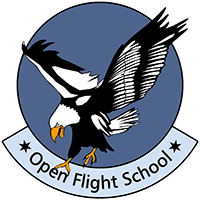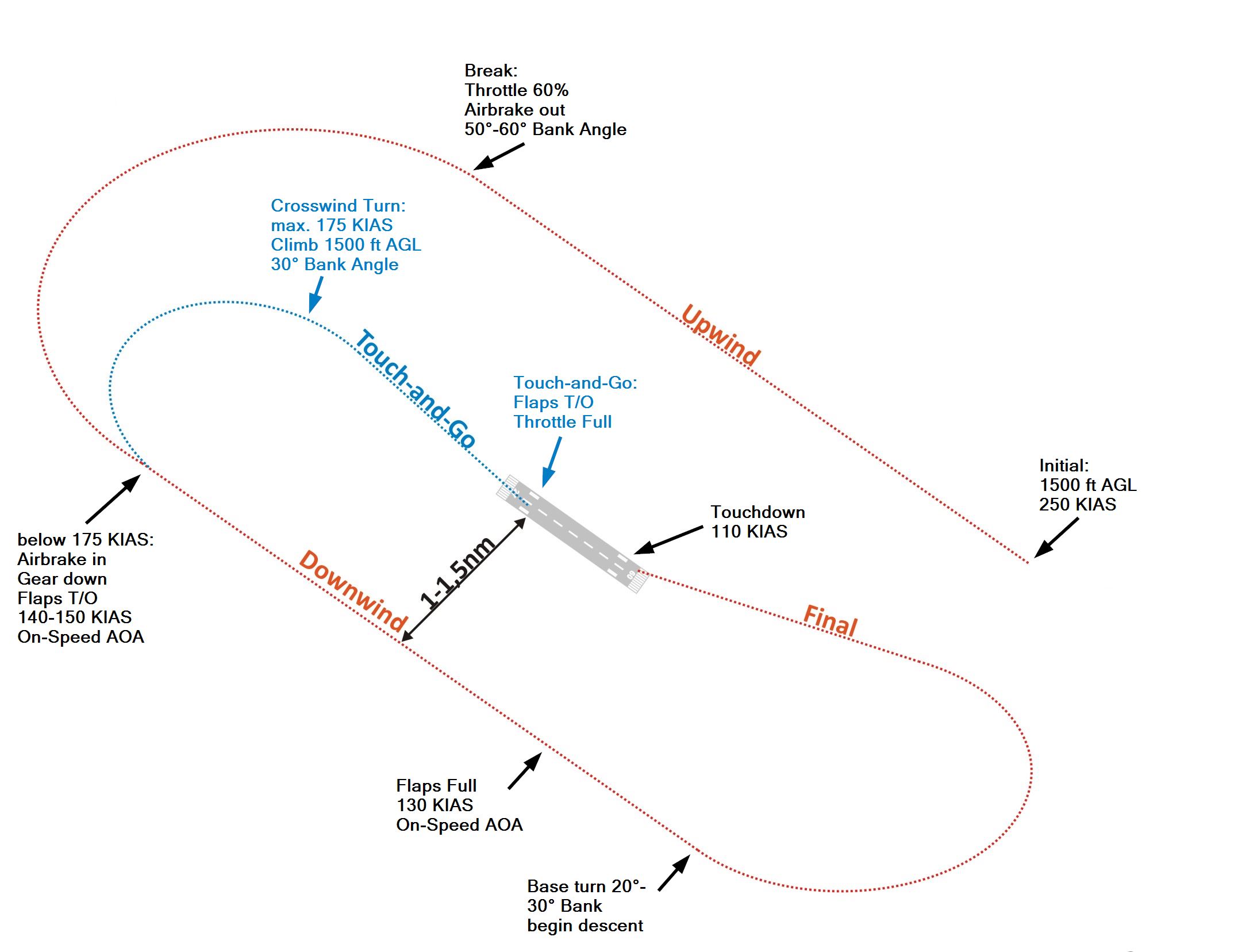Simplified Procedures in Detail
10. Flying the Circuit Pattern
To practice this start the mission 05 Circuit Pattern.
Normal VFR Circuit
The circuit is a standardised procedure for the arrival of aircraft under Visual Flight Rules (VFR).
The approach and circuit with the MB-339 is described below.
Initial
The circuit begins at the Initial Point, which is 3-5 nm before the runway. At this point you should have a height of 1,500 feet AGL (above ground level - QFE - Not RadAlt) and 250 knots.
The Navy fly the circuit at a height of 800 ft, however this circuit will follow the Air Force pattern of 1500 ft AGL.
Upwind Leg
On the Upwind leg you fly slightly to the right to the runway at 1500 ft AGL and pass the airport. Take the opportunity to look at the airport to get an overview of the area.
- Maintain 1,500 feet and around 250 kts to clear of the runway at the far end by about 1 mile.
Break
The Break is a 180⁰ level turn to the start of the Downwind.
- Break into the "Circuit" with about 50⁰ - 60⁰ Angle of Bank (AoB)
- Reduced power to 60% RPM and the Speedbrake. SPEEDBRAKE OUT HOTAS
- Hold the level turn until 250⁰ (the opposite of Runway 07) to start the "Downwind"
Downwind Leg
The Downwind Leg is abeam the runway spaced out by about a wing's width visually. I.e. the runway appears to pass under the wing tip of the aircraft.
Having arrived at the start of the Downwind and as the aircraft slows below 175 knots:
- Extend the Landing Gear GEAR DN and LOCKED / THREE GREENS LSC
- Retract the Speedbrake SPEEDBRAKE INHOTAS
- Lower first stage of Flaps to Take-off, FLAPS T/OLSP
The aircraft's speed will still be reducing so:
- Progressively Trim up to maintain level. This will bring the AoA Indicator into the White band which is "On-speed".
- Increase power to catch about 140 kts
When passed the Runway to a point where the threshold aligns with our left wing (about 8 o’clock), we are at the end of the "Downwind":
- Select Full Flaps, FLAPS DOWNLSP
Base Leg / Turn
The Base Leg is actually a descending turn to align facing directly down the runway.
- Start a descending turn using about 20⁰ - 30⁰ AoB
- Allow the aircraft to slow to 130 kts and trim to maintain "On-speed" AoA.
- Aim for about 1,000 fpm Rate of Descent
- Roll out on Final approach at about 500 ft.
The turn should be almost a smooth glide, but never select less than 60% RPM to ensure the engine will "spool up" in time if required.
Keep an eye on the runway to be able to correct errors in rate of descent and rate of turn as necessary, so that we roll out aligned with the runway exactly. Try to avoid overshooting the centre line.
Final
The Final is the leg from 500 ft to the threshiold.
At approximately 500ft with the aircraft slowing to about 115 kts remaining On-speed AOA and on centreline, the rest of the final approach is identical to the section "Normal Landing".
Notice the position of the threshold in the windscreen. It should remain stationary with everything around it expanding. However:
- If it is moving up increase thrust to reduce the rate of descent
- If it is moving down reduce thrust to increase the rate of descent.
As the threshold arrives look to the far end of the runway ONLY and perceive the ground approaching beneath you.
Just short of the ground:
- Pitch slightly up to flare, without climbing, and cut the throttle to idle. THROTTLE IDLE HOTAS
- This will reduce the rate of descent.
- Hold this attitude too wash off the remaining speed and touch down at about 95 - 100 kts..
On touch down, maintain the attitude by progressive pitch up. This gives aerodynamic braking.
As the airspeed decays to about 70 kts, lower the nose wheel.
Maintain the centreline with rudder and then differential braking, and come to a full stop.
Touch-and-Go
If you want to practice the circuit pattern several times in a row, then you use the Touch-and-Go procedure.
In this case, continue along the runway and
- Select full power THROTTLE FULL HOTAS
- Select Speedbrake in. SPEEDBRAKE IN HOTAS
- Change Flaps to takeoff position.
- Check full RPM and pitch to start a climb at about 7⁰ - 10⁰ Nose up.
- Climb to 1,500 ft agl while completing the After Take-off Checks.
- Passing 1,000 ft turn left to rejoin the downwind. From there, the circuit and landing approach can be repeated.


